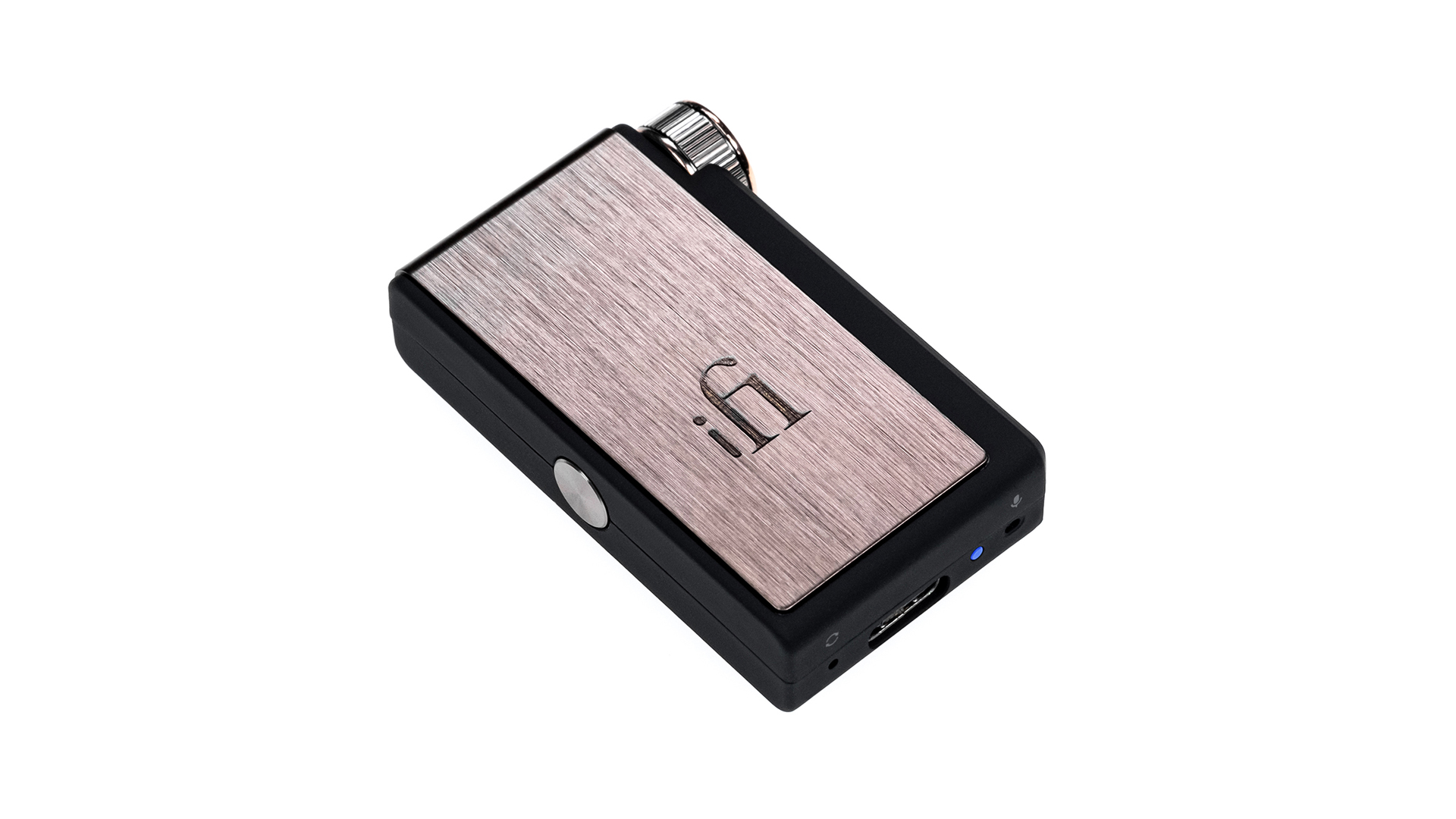What Hi-Fi? Verdict
When portability is paramount, the iFi Go Blu is every millimetre the convenient sonic upgrade your phone needs
Pros
- +
Detailed, expansive presentation
- +
Wired or wireless connectivity
- +
Balanced and unbalanced inputs
Cons
- -
No notification for bitrate
Why you can trust What Hi-Fi?
The past six months has seen iFi gain two glowing five star-reviews from this publication and one What Hi-Fi? 2021 Award: not bad going for a firm that only came into being in 2012. The UK outfit carved a niche for itself by fashioning mostly small, always likeable, sometimes hipflask-shaped aids for your in-transit or on-desk sound, and the iFi Go Blu DAC/headphone amp is no exception – except that the promotional shots make it look more like a premium lighter than a vessel for alcohol.
The headline is that this portable DAC/headphone amp offers a Bluetooth 5.1 connection to your source device (although not to your headphones, those still need to be wired into the unit) thus eliminating one wire from the potentially bulky, tangled equation of phone, to DAC, to headphones. But is it a thing of beauty, sonically-speaking, or just a pretty Christmas stocking-filler? We’ll soon see.
Price

With its £199 ($199, AU$299) price-tag and novel wireless capabilities, there’s not a lot of competition out there for the iFi Go Blu. However, the five-star, What Hi-Fi? 2019 Award-winning Audiolab M-DAC Nano (£149, $199) is one fine example of such a beast – albeit sporting the slightly older Bluetooth 4.2 chipset. Otherwise, we’d have to direct you to the AudioQuest DragonFly Cobalt (£269), a fantastic fuss-free USB plug-in DAC for your phone or laptop – but of course, that is not a wireless proposition...
Build

Given that we had seen photos of the Go Blu prior to holding it, we couldn’t have been more surprised upon actually unboxing it and doing so. With no other items for scale comparison in the promo shots, you’d be forgiven for thinking the iFi Go Blu would size up comfortably to a portable music player such as the Astell & Kern Kann Alpha. So imagine such a product, then shrink it to a fifth of its size. The Go Blu is truly tiny; its footprint is barely bigger than two UK postage stamps placed side by side. It also weighs in at just 26g, making it lighter than an AA battery.
Though it is small in stature, the iFi Go Blu is mightily attractive. The first thing you notice is the rotary dial in the top right corner. This clicks reassuringly and can be turned for volume control, or pressed in various ways to play, pause, skip tracks or access your phone’s voice assistant. Because of its dimensions, this dial looks like a premium chronograph watch crown, an aesthetic aided by the lightweight, soft-touch polymer front plate which feels for all the world like copper – but unlike signal-blocking metal, it helps with Bluetooth reception. Our only minor gripe here is the black rubberised plastic casework, which makes the unit feel just a tiny bit flimsy, especially when we often find ourselves picking it up off the floor owing to its lightness and propensity to get pulled off our desk by our headphone cable during testing.
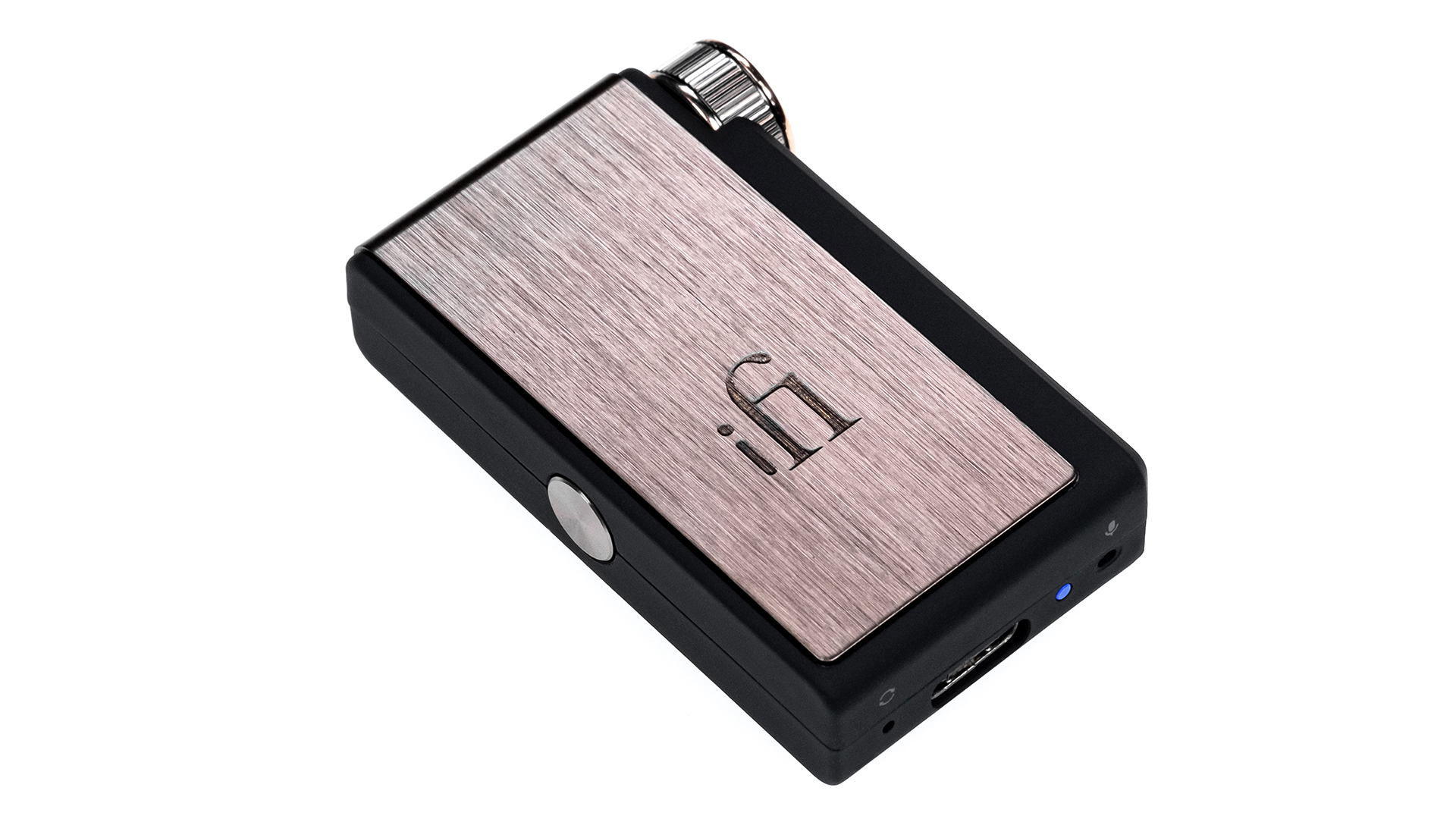
Battery life 10 hours (charging time: 40 minutes)
Dimensions 54 x 34 x 13mm
Weight 26g
Bluetooth 5.1 with aptX HD, aptX Low Latency, aptX Adaptive, LDAC
Headphone outputs 3.5mm, 4.4mm
Underneath the volume dial is a settings and Bluetooth function button, which can be pressed to cycle through various sound effects: XBass, XSpace, the two combined, or off entirely. When you do so, an LED on the top of the Go Blu glows yellow to signify you’re listening using XBass, light blue for XSpace, white for the two combined, or off when no profile is deployed.
Next to this LED, you get balanced and unbalanced headphone jacks, so (unlike with the Audiolab M-DAC Nano) you’re covered whether your chosen wired headphones sport the niche Pentaconn 4.4mm output or the more common 3.5mm connector –and you’re getting iFi’s proprietary S-Balanced circuitry used throughout.
The latest hi-fi, home cinema and tech news, reviews, buying advice and deals, direct to your inbox.
Along the left side of the unit is a dedicated power button, and on the bottom edge is a multi-use USB-C port (more on this later) and a little factory reset button you’d need a pin to push. There's also an LED for battery status – you can get up to 10 hours, so when it’s flashing green you’re good, yellow and you should think about charging, and red, you really need to charge. Juicing up takes a maximum of 40 minutes. Lastly, there's a chip-based CMOS-MEM microphone to enable hands-free calls, gaming talk and access to voice assistants including Apple Siri and Google Assistant.
Back to that USB-C socket, because interestingly, it isn’t just for charging. It doubles as an audio input, enabling USB connection from your source device. Hi-res PCM files up to 24-bit/96kHz are supported when the Go Blu is connected in this way, thus differentiating the product substantially from the Audiolab M-DAC Nano, which only offers a Bluetooth connection. It’s an impressive little proposition, thus far.
Features
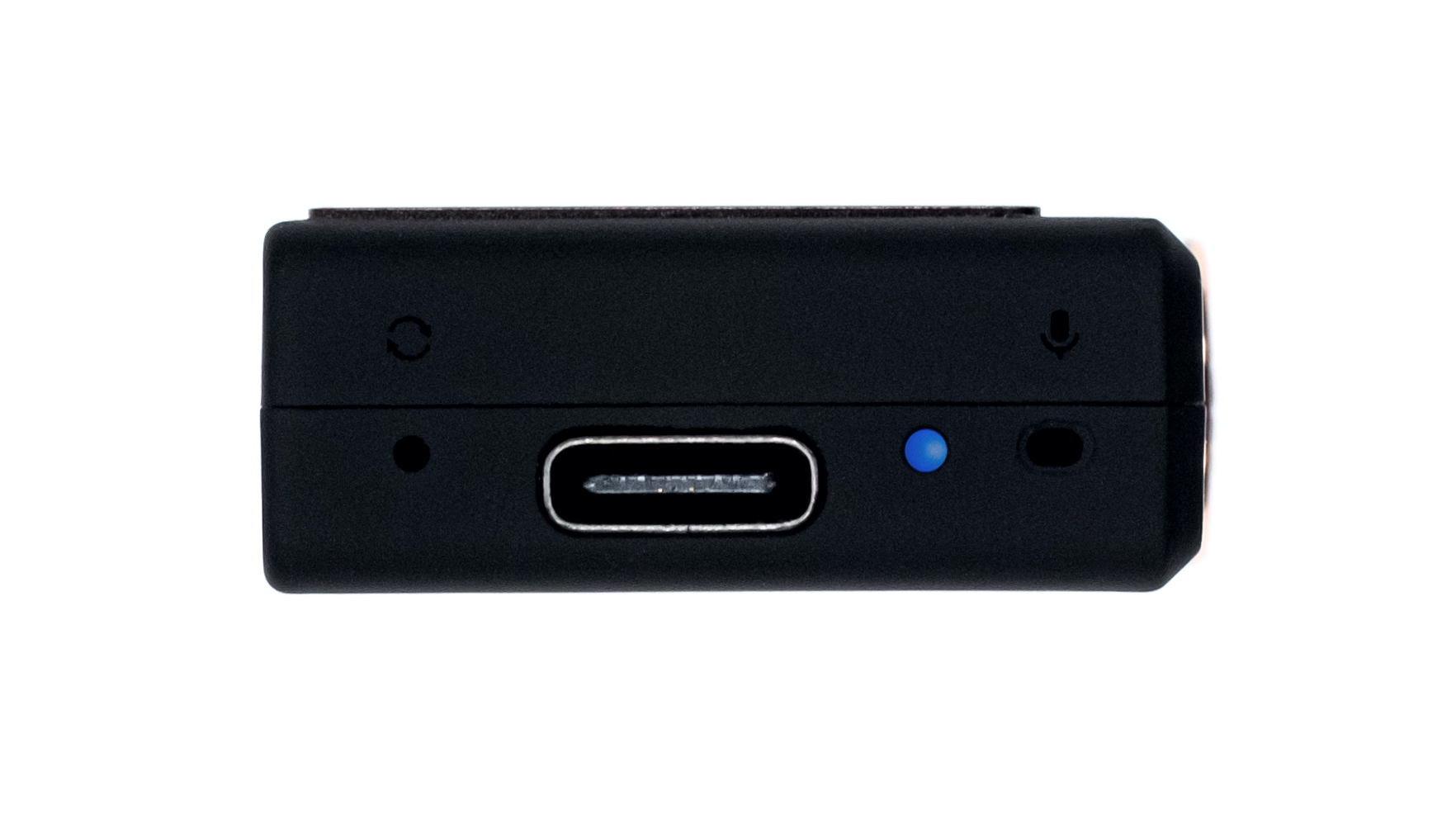
The Go Blu supports Bluetooth 5.1 and every current Bluetooth audio format is supported, including aptX HD, aptX Adaptive, aptX Low Latency, LDAC, LHDC, AAC and plain old vanilla SBC.
iFi is quick to point out that, uniquely for a device of this size and type, the Go Blu features distinct Bluetooth, DAC and amp stages, each engineered in separate blocks. At its heart, then, is the Cirrus Logic 43131 32-bit DAC chip – although it’s important to remember that unless you’re using wires (wherein your audio quality will max out at 24-bit/96kHz via PCM), Bluetooth streaming has an impact on the resolution of your music.
Although the Go Blu’s XBass, XSpace and combination sound effects offer customisation for your music, if we had to choose one feature we would prefer, it’d be the option to enable 32-bit SRC upscaling (from 16-bit) which is offered by the Audiolab M-DAC Nano. Although the Go Blu does indeed make your streamed music sound better (more on this below), the specifics are a little harder to pin down and there’s no LED to denote upscaled bitrates on the device.
In terms of amplification, we find the iFi has no issue driving the open-backed Grado SR80x (£130 ($125/AU$179) to high volume levels.
Pairing is a breeze. When connecting to our iPhone, there’s a tone to confirm successful pairing and a voice to announce the audio file type you’re listening to (in this case, the voice simply says ‘AAC’). Similarly, we’re able to connect physically to our MacBook Pro using our USB-C-to-USB-C cable (although you will need to buy this separately if you don’t already own one) and selecting the Go Blu in the sound output settings tab on our computer. It’s a neat and versatile setup that facilitates a solid step up in sound quality, however you connect.
Sound
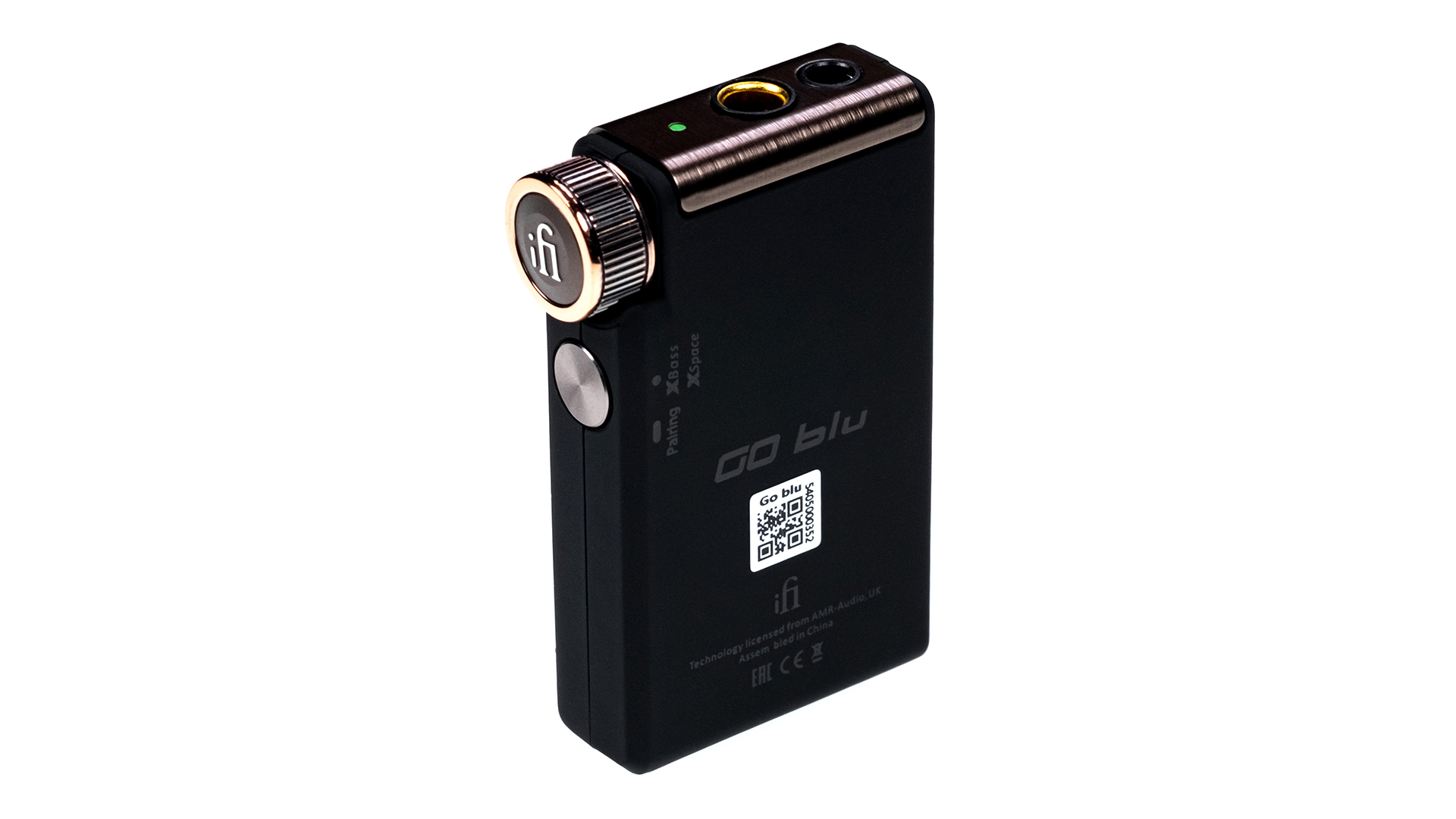
We cue up John Mayer’s Shouldn’t Matter But It Does on Tidal and, in the name of like-for-like comparison, Bluetooth pair both the Audiolab M-DAC Nano and iFi Go Blu (with no sound effects deployed) to our iPhone. Almost immediately we become aware that the iFi Go Blu serves up a wider soundstage. The guitar is sensitively strummed and Mayer’s central vocal is crisp and emotive as occasional keys sparkle through the easy treble and a soft, walking bass guitar reminds us that the low-end is also being held in check. In direct comparison, the M-DAC Nano is fractionally punchier through the bass registers but it’s also a little cruder and marginally more congested.
Switching back to the Go Blu and streaming West Indies by Koffee, we note that the initial vibraphone-esque keys in our left ear are faithfully relayed with clarity and zeal. As the beat drops, the soundstage extends to both ears and really goes deep into the lower registers. The M-DAC Nano is similarly neutral and clear but doesn’t offer quite the same levels of separation and dynamic sensitivity, although it is a closely run race.
167 by Farruko and Gallego opens with the sound of motorbikes and cars driving past on the 167 freeway. With the iFi Go Blu, it is as lonely a setting as the artist intended and feels as if we are hitch-hiking at the side of the 167 in Puerto Rico. Each car tracks from one ear to the other – a sensation the Audiolab product is unable to match with similar precision. The horns, pensive keys and deep Spanish vocal are exciting, but the Go Blu is sensible too, reserving just enough to add the required bite to the reggaeton rap section as the track progresses.
Verdict
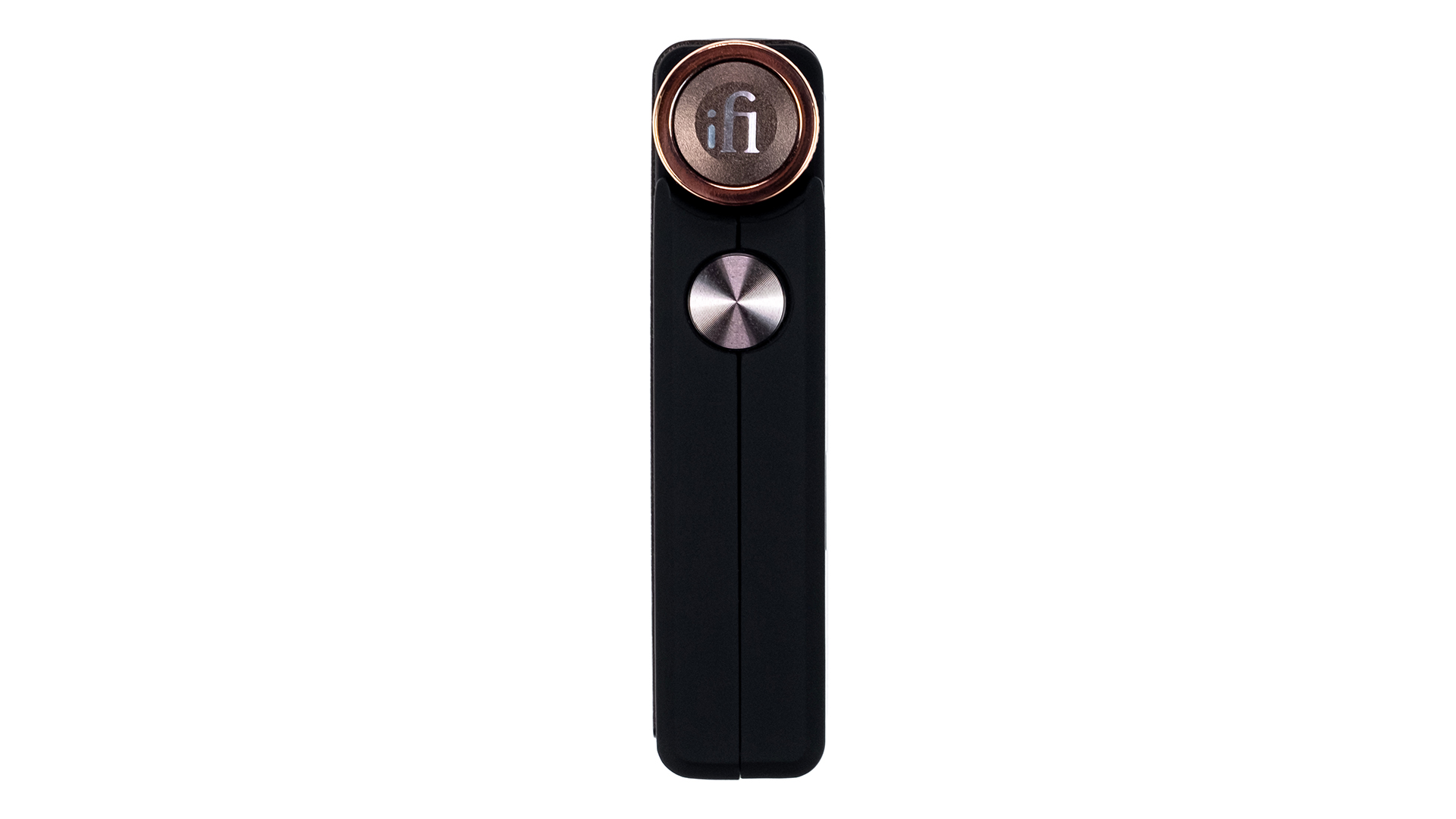
When discussing DACs to improve the sound quality of your music, Bluetooth puts the cat among the pigeons owing to the inescapable truth that its delivery has yet to catch up with both wi-fi and wired listening for a truly high fidelity sound. However, when portability is paramount and convenience is key, you cannot currently better the iFi Go Blu. It levels up your phone’s sound with very little effort or added weight in your pocket or strain on your wallet. It can sit in the tiny watch pocket of your jeans, doing its good work nowhere near your actual phone, and if you’re working in a cafe, it will both look and sound exceptionally good next to your flat white. Highly recommended.
SCORES
- Sound 5
- Features 5
- Build 4
MORE:
Read our review of the Audiolab M-DAC Nano
Read our AudioQuest DragonFly Cobalt
Read our round-up of the DACs: USB, portable and desktop DACs
What Hi-Fi?, founded in 1976, is the world's leading independent guide to buying and owning hi-fi and home entertainment products. Our comprehensive tests help you buy the very best for your money, with our advice sections giving you step-by-step information on how to get even more from your music and movies. Everything is tested by our dedicated team of in-house reviewers in our custom-built test rooms in London, Reading and Bath. Our coveted five-star rating and Awards are recognised all over the world as the ultimate seal of approval, so you can buy with absolute confidence.
